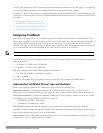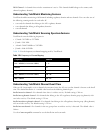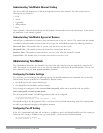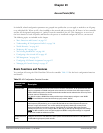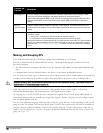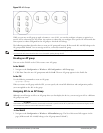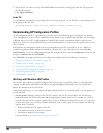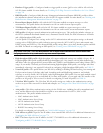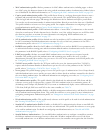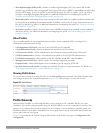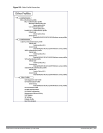
396 | AccessPoints(APs) DellPowerConnectW-SeriesArubaOS6.2 | User Guide
2. Select the AP you want to reassign, and click Provision. From the Provisioning page, select the AP group from
the drop-down menu.
3. Click Apply and Reboot.
In the CLI
Use the following command to assign a single AP to an existing AP group. Use the WebUI to assign multiple APs to
an AP group at the same time.
ap-regroup {ap-name <name>|serial-num <number>|wired-mac <macaddr>} <group>
Understanding AP Configuration Profiles
An AP configuration profile is a general name to describe any of the different groups of settings that can defined,
saved, and applied to an Access Point. ArubaOS has many different types of profiles that each allow you to configure
a different aspect of an AP’s overall configuration. ArubaOS also contains a predefined “default” profile for each
profile type. You can use the predefined settings in these default profiles, or create entirely new profiles that you can
edit as required.
Each different AP configuration profile type can be managed using the CLI or the WebUI. To see a full list of
available configuration profiles using the command-line interface, access the CLI and issue the command show
profile-hierarchy. To view available configuration profiles using the WebUI, select the Configuration tab in the and
navigate to Advanced Services>All Profiles.
The All Profiles tab arranges the different AP configuration profile types into the following six categories:
l "Working with Wireless LAN Profiles" on page 396
l "Working with AP Profiles" on page 399
l "Working with QoS Profiles" on page 399
l "Working with RF Management Profiles" on page 400
l "Provisioning Mesh Profiles" on page 400
l "Other Profiles" on page 401
Working with Wireless LAN Profiles
The Wireless LAN collection of profiles configure WLANs in the form of virtual AP profiles. A virtual AP profile
contains an SSID profile which defines the WLAN, the high-throughput SSID profile, and an AAA profile that
defines the authentication for the WLAN.
Unlike other profile types, you can configure and apply multiple instances of virtual AP profiles to an AP group or to
an individual AP.
l 802.11k profile—Manages settings for the 802.11k protocol. The 802.11k protocol allows APs and clients to
dynamically query their radio environment and take appropriate connection actions. For example: In a 802.11k
network if the AP with the strongest signal reaches its CAC (Call Admission Control) limits for voice calls, then
on-hook
voice clients may connect to an under utilized AP with a weaker signal. You can configure the following
options in 802.11k profile:
l Enable or disable 802.11K support on the AP
l Forceful disassociation of on-hook voice clients
l Measurement mode for beacon reports.
For more details, see "Enabling 802.11k Support" on page 333.



